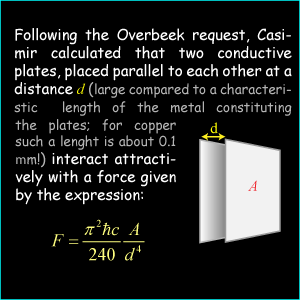| CASIMIR EFFECT: The history |1|2| | |
... IN THIS WAY, he turned to his colleague theorist Hendrik Casimir, asking him to investigate the problem. Casimir, in collaboration with Dirk Polder, another researcher working at Philips, used quantum electrodynamics to calculate the form taken by the interaction "a la" van der Waals when the finiteness of light speed is taken into account. In 1948, taking forward the line of thought that had guided him, Casimir formulated a general theory for such a kind of interactions, and applied it to the case of two perfectly conducting plates placed parallel to each other at a small distance (see box). |
|
In the Fifties the Soviet physicist Evgeny Lifshitz extended the Casimir theory to the case where plates are not perfect conductors. Thus it was possible to generalize the concept of the Casimir effect to a broader class of materials, including insulators. |
 |
To know more: |
|